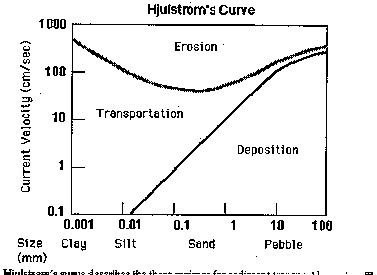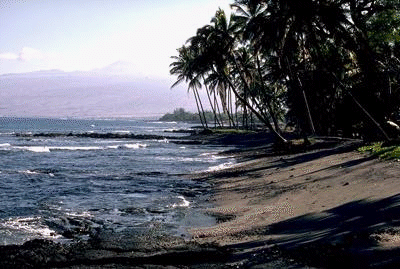
[ home port | lectures | labs | discussion | announcements | surf | email prof. ]

 Lab 3
Lab 3
Things to Get Out of This Lab:
Materials: Invitation to Oceanography textbook
Introduction
The surface of the Earth is constantly changing. Continental mountains are "wearing down" and other portions of continents are being created or uplifted by volcanoes, rising buoyant material from below the crust, by compression which thickens and raises the crust (e.g., the collision of India into Eurasia), or by the addition of new material to the continents as sediments are scraped off the top of subducting plates. The exposed rocks that form the mountains are broken down into smaller particles by weathering processes and, through a variety of transport processes (water and air are 2 examples), eventually make their way to the sea. This relentless march of sediments to the sea determines the temporary nature of water storage dams, which will eventually fill with sediments and become useless as reservoirs.
Sediments are earth materials that are deposited in particulate, unconsolidated form. Sand and mud are examples of sediments. The grains of sand or particles of mud form a loose aggregate rather than a solid chunk (e.g., a rock). The most abundant sediments come from the weathering and chemical breakdown of continental rocks. Buried with the sediments are skeletons of the animals that lived during that time. When the sediments are undisturbed by geologic forces, the oldest are at the bottom of the sediment "column" and the youngest are at the top. This sediment "column" provides a remarkable record of the earth's history. It records not only the rock type, but the environment within which the sediment was deposited (sea, land, etc.). Also, the shape of a sediment particle (angular, rounded, etc.) is another indicator of its history. For example, older particles will be more rounded due to weathering. Because certain kinds of animals and plants lived only during certain time periods, the types of fossils found in sediments allow scientists to determine the approximate date at which they were deposited. The chemical composition of these fossils provides clues about the chemical environment of deposition, including the temperature of the ancient earth (paleotemperature).
Outlines (Use Your Textbook to Fill in the Following)
Sediment Sources
For each of the following kinds of sediments:
Lithogenous sediments:
origin =
example =
Biogenous Sediments:
origin =
example =
Hydrogenous Sediments:
origin =
example =
Cosmogenous Sediments:
origin =
example =
Mechanisms of Transport
Sediments can be transported by water, wind, glaciers, plate motion, volcanic activity, and biological activity. For each of the following kinds of sediments list as many transport mechanisms as you can:
Lithogenous sediments:
Biogenous Sediments:
Hydrogenous Sediments:
Cosmogenous Sediments:
Transport by water is one of the most common mechanisms for the transport of lithogenous sediments. When there is a large rainstorm, the ocean water turns brown with the sediments transported from the coastal mountains by the runoff. Dams that store water are slowly filled with sediments that are transported to it by the streams that fill the lake behind it, decreasing their capacity. Our beaches are made up of sediments transported from the hills by the streams and rivers that drain into the ocean, and are deposited onto the beaches by the longshore currents.
The figure on the next page shows "Hjulstrom's Curve," which describes the three regimes of the transport of a sediment grain by flowing water.

When particles are being carried along without deposition, they are in the transportation regime. The smallest grains may be transported by very slowly moving water, while it takes progressively faster water velocities (higher turbulence or "energy") to carry larger particles. At high current speeds sediments may be lifted from a previous deposit and carried along. This is the erosion regime. In the figure above note the minimum in the erosion curve which is linked to a high degree of particle cohesion. When the current slows and particles settle to the bottom, they are in the deposition regime. To tell what regime a particle is in, you must know the particle diameter and the water velocity. Find the appropriate regime from the plot by locating a velocity and particle size. For example, a 0.1 mm particle in a 10 cm/sec current will be in the transportation regime. It will not be deposited, but will be carried along until the current velocity decreases to below about 1 cm/sec. At this velocity it will begin to fall to the bottom and become deposited on top of undisturbed sediments. Once that 0.1 mm particle has been deposited, it will take a current of about 30 cm/sec (or greater) to resuspend and transport it further.
When sediment travels a long distance, larger particles (which settle out more quickly) are left behind, which means that deposits farther from the source will consist of smaller grains. Also, grains that travel a long distance will become progressively rounder as the sharp edges get smoothed by bumping against other grains. Because larger particles sink faster, one commonly finds larger particles at the bottom of a depositional sequence and finer particles at the top. This may happen, for example, if a large rainstorm or landslide initiated a flow of sediments into a body of water. Large particles would fall out first, then smaller ones would settle later. This "sorting" of sediments by size is commonly used to identify sediments that were transported by water, or to identify the top of sediments in regions where the sediment record might have been rotated or inverted by geologic processes.
Now you should be ready to work through the following questions:
(1) A stream flows rapidly after a rainfall. If the water velocity is 1 m/sec. Use Hjulstrom's Curve to indicate whether the following particles will sink to the streambed, stay suspended in the water, or erode from the streambed (check the appropriate choice):
Clay, size 0.001 mm: sink_______ stay suspended _______ erode from bottom _______
Silt, size 0.05 mm: sink_______ stay suspended _______ erode from bottom _______
Sand, size 1.0 mm: sink_______ stay suspended _______ erode from bottom _______
Pebble, size 50 mm: sink_______ stay suspended _______ erode from bottom _______
If the stream is flowing at 1.0 cm/sec, use Hjulstrom's Curve once again to indicate whether the following particles will sink to the streambed, stay suspended in the water, or erode from the streambed (check the appropriate choice):
Clay, size 0.001 mm: sink_______ stay suspended _______ erode from bottom _______
Silt, size 0.05 mm: sink_______ stay suspended _______ erode from bottom _______
Sand, size 1.0 mm: sink_______ stay suspended _______ erode from bottom _______
Pebble, size 50 mm: sink_______ stay suspended _______ erode from bottom _______
(2) In the early 1950's, there was very little topographic data available for the ocean floor. Marine geologists expected to find a rather flat, featureless shape to the ocean basins. This was based on the knowledge that continents are quite old, and erode on average, at rates of about 10 meters / million years. If the oceans are as old as the continents, one would expect that all of this sediment would be distributed throughout the ocean basins, filling in the troughs and slowly covering up any high points, as well.
(a) Assuming that the continents have been eroding into the ocean for the entire life of the earth (say for at least 4000 million years), calculate the average thickness of sediments (in MILES) that would be expected in the ocean basins. (Conversion factors can be found in the Appendix at the back of this manual).
(b) Do you think that the seafloor topography, as it is now known, supports the idea that the ocean basins are very old features? Why or why not?
Observations of Sediments
The next time that you are at the beach or along a river bank, take some time to observe the sand. Think about what type it might be (from continental rocks?, volcanic rocks?, biological material such as shells?, etc.) and its grain size (coarse or fine-grained).

Last update: March 14, 1999
http://dusk.geo.orst.edu/oceans/lab3.html
Dawn Wright & Bob Duncan © 1999